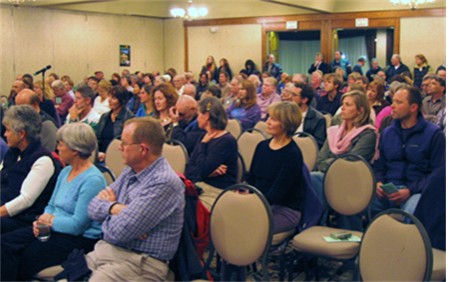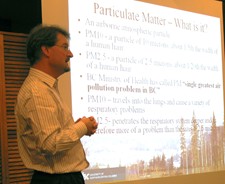Residents Air Their Anger
By 250 News

Crowd fills room at Coast Inn to hear about Air Quality issues
About 165 Prince George residents turned out to a public forum organized by PACHA, the People's Action Committee for Healthy Air. They came with questions, they demanded answers. They didn't get everything they wanted.
Dr. Peter Jackson started off the two hour forum with a basic lesson, call it "Air Pollution 101". He tried to explain the progress that has been made, and the new challenges facing the community, namely Pm 2.5, that very fine particulate which is about 1/20th of the width of a human hair. It is so fine it is inhaled deeply into the lungs. The B.C. Ministry of Health says Pm 2.5 is the single greatest air pollution problem in B.C., yet not all communities monitor for Pm2.5 Prince George is one which does, and it has the dubious distinction of being in the top three worst cities for Pm2.5
One Prince George monitoring site is at the top of the list with the highest levels, followed by Williams Lake, and in third place is a second Prince George monitoring site.
 Dr. Jackson (at left) says right now, early research suggests 40% of the Pm2.5 comes from industry, 40% from other sources like cars, burning, street cleaning, and the 20% balance may be ambient from sources that cannot be identified.
Dr. Jackson (at left) says right now, early research suggests 40% of the Pm2.5 comes from industry, 40% from other sources like cars, burning, street cleaning, and the 20% balance may be ambient from sources that cannot be identified.
He says there is no real definintive answer as to who or what is creating this fine particulate "We don't have a grip on the sources, we need to know the sources so we can find out which ones we can control to reduce the problem."
It is a major problem.
One of his students at UNBC is conducting a study of Pm2.5 levels at schools in Prince George. The national marker for this particulate is not to exceed an average of "30" over 7 days of the year. During the sampling for the study, the levels at Carney School were nearly twice that mark.
Residents don't have a lot of patience when it comes to waiting for the results of more studies "I am not prepared to wait 15 years for study after study" exclaimed one man "I want to see some action!" His message was repeated by others who expressed frustration at waiting for the science before any measures are taken. One man asked how many others in the crowd could match or top the more than one thousand dollars he has spent so far this month for medications to cope with asthma. There were no takers.
Dave Sutherland of the Ministry of the Environment told the group their voices are welcome "We are trying to do the science, we are trying to find out stack by stack just who is putting what into the air, we're trying to come up with the technical solutions, but ultimately they will cost money and there will be economic implications so there will be discussions about what the trade off is. The public needs to express itself on what direction it wants to go. So I am really glad to see this tonight."
Some of the Questions:
- Who makes the rules? In the case of asphalt plants, it was explained the plants fall under a "regulation" which means as long as the standards are being met, there is little that can be done, unless of course the people want to press the government to change the standards. (see Asphalt Plants To Develop Plan)
- Who is responsible for what? The Ministry of the Environment is responsible for air shed issues as they apply to industry, however, the municipality can make those regulations tougher.
- When it comes to studies, why re-invent the wheel? While its true Quesnel has already moved into its second phase of an Air Quality Management Plan ( P.G. has yet to unveil it's phase 2 outline) the Quesnel plan can't just be picked up and transposed on to Prince George. "Prince George has a totally different setting, and while the two cities are close when it comes to distance, they are miles apart when it comes to air shed issues" says the Ministry's David Sutherland.
- What can be done about open burning of mountain pine beetle debris? The rules for burning land debris can be strengthened through the permits issued by the Fire department.
Previous Story - Next Story
Return to Home










Here's a sample of what might be found. Did you know that when you bring in your computer for servicing, the tech can tell how clean you keep your house. The most dustiest computers come from the houses that get the most cleaning. The more we clean, the more we stir up fine dust, and therefore the dirtier the air we live in.
Pavement and concrete are major contributors of fine dust that our ancestors didn't have to contend with. When their streets got dusty, they could see it. So they would add oil or water to knock down the dust. Of course we baby Boomers wanted better and now we complain about the results! Hee Hee!
The other indicator that this is really a silly issue is the fact Councillor Brian Skakun is involved. Brian's on your side, you lucky people, Hee hee!